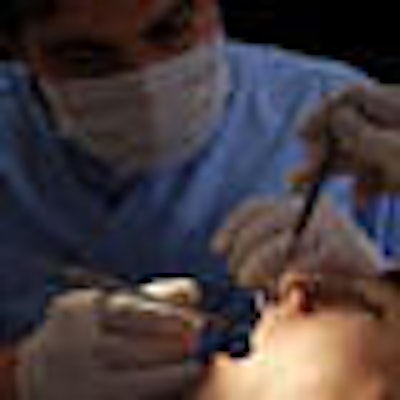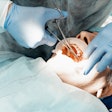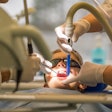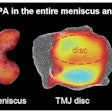
Patients face a greater risk of developing bacteremia following dental extractions (BDE) under general anesthesia than local anesthesia, according to a new study by researchers from the University of Santiago de Compostela (Oral Surgery, Oral Medicine, Oral Pathology, Oral Radiology, and Endodontology, December 2010, Vol. 110:6, pp. 706-712).
After collecting blood samples from 210 patients with varied oral health, the researchers found that general anesthesia consistently increased incidences of BDE both in prevalence and duration.
One of the authors, Inmaculada Tomás Carmona, DDS, PhD, has studied the presence of bacteremia extensively, particularly as a result of dental procedures. In 2004 and 2005, her team explored treatments for streptococci found in the bloodstream after dental extractions using antibiotics, while prevention through antibiotics was the focus of a follow-up study in 2006 (Oral Microbiology & Immunology, October 2004, Vol. 19:5, pp. 331-335, and February 2005, Vol. 20:1, pp. 35-38; Antimicrobial Agents & Chemotherapy, September 2006, Vol. 50:9, pp. 2996-3002).
While bacteremia treatments guided the course of several of these studies, Dr. Carmona observed rates of occurrence after dental procedures in others. A precursor to her current study took place in 2006 when she examined rates of bacteremia in pediatric patients who had undergone various dental procedures under general anesthesia (Congenital Heart Disease, September 2006, Vol 1:5 p. 224-8).
Similarly, in a 2007 study, she and Maximiliano Álvarez, MD, PhD, who also worked on the current study, analyzed the prevalence, duration, and etiology of bacteremia after extractions (Oral Diseases, January 2007, Vol. 13:1, pp. 56-62). The majority of the subjects developed bacteremia, most commonly streptococcal, regardless of their oral health and the number of teeth extracted during the procedure. That study also cast "significant doubt on the supposedly transient nature of bacteremia following dental extractions," they noted. Their findings led Dr. Carmona and her colleagues to recommend that patients rinse with a 0.2% chlorhexidine mouthwash prior to extractions.
They narrowed their scope to third-molar extractions in another 2007 study that produced similar findings in one respect: Rates of bacteremia were high in all patients no matter the quality of their oral health or the number of extractions performed (Infection Control & Hospital Epidemiology, May 2007, Vol. 28:5, pp. 577-582).
While this study suggests that the condition of patients' oral health has a limited impact on the prevalence of BDE after extractions, Dr. Carmona and her colleagues acknowledged in the current study that the issue remains controversial. They also cited other studies suggesting the appearance of bacteremia was unrelated to the aggressiveness of the surgical intervention.
Methodology
However, while conflicting studies exist about the impact the number of teeth removed has on BDE, Dr. Carmona and her team chose to focus on the influence of anesthetic techniques on BDE prevalence in the current study because while it has been shown that local anesthesia and endotracheal intubation can cause bacteremia, few studies on their roles have been performed, they noted.
They analyzed 210 patients (98 men and 112 women) with learning disabilities who underwent dental extractions. They had excluded those who were uncooperative, had received antibiotics in less than three months prior to the study, regularly used oral antiseptics, showed a positive blood culture at baseline, or had disease that predisposed them to infection. After examination by a single dentist two days prior to surgery, each patient was graded using the global oral health range from 0 for a healthy mouth to 3 for a neglected mouth. Of the 210 patients, 78 were graded 0-1 and 132 were graded 2-3. An average of two teeth per patient were removed.
Local anesthesia was administered to 98 patients, and the remaining 112 received both general and local anesthesia. Bacteremia was found in 71% of the patients at 30 seconds after completing the first dental extraction, and 45% and 13% at 15 minutes and 1 hour, respectively, after completing the final extraction, according to the researchers. Streptococcus was the most common bacterial genus at 64%, followed by Staphylococcus at 11%.
In the univariate analysis, at 30 seconds the variables that had a significant effect on BDE were oral health status, local anesthetic technique (modified intraligamentous, infiltrative, or regional block), and anesthetic modality, local only, or general and local anesthetic. When 15 minutes had passed, the variables that affected BDE were the same with the addition of the number of extractions. An hour after the last extraction was completed, the quality of the patients' oral health ceased to be a factor, while the number of extractions, local anesthetic technique, and anesthetic modality impacted BDE rates.
Interestingly, in the multivariate analysis, only anesthetic modality significantly affected the prevalence and duration of BDE:
|
Consequently, the researchers focused their discussion on this aspect of the study's outcome. Few studies that directly addressed the influence of anesthetic modality were uncovered, and of those the conclusions drawn were inconsistent. One group thought that nasotracheal intubation "potentiates" BDE's prevalence and durations.
Three hypotheses
Dr. Carmona and her team developed three hypotheses to potentially explain their findings. The first suggests that bacteremia appears after maneuvering a nasotracheal tube. Reinforcing this theory was the occurrence of positive postintubation blood cultures of 33% in adults and 18% in children in two series of patients undergoing dental treatment.
The second hypothesis suggested that transitory changes in blood flow and an immune response to anesthetic agents was the cause. Propofol studies have proved in vitro that the concentrations used in general anesthesia significantly inhibited the oxidative metabolic activity of neutrophils compared with other hypnotic agents, the researchers noted. However, they also acknowledged that there is no consensus on the immunosuppressive effect of anesthetic agents.
The final hypothesis simply supposes that the anesthetic agents could be contaminated. However, instances of complications from contaminated propofol, for example, are typically due to a lack of adequate measures taken by the anesthesiologist to control cross infection, the researchers noted.
As a result, "there is substantially more risk for the prevalence and duration of BDE under general anesthesia than local" and "the inclusion of this anesthetic modality among the 'risk factors' for BDE should be reconsidered," they concluded.
Copyright © 2010 DrBicuspid.com



















